

Infectious diseases. Pandemic Awareness. About Pandemics. A pandemic is a global disease outbreak.
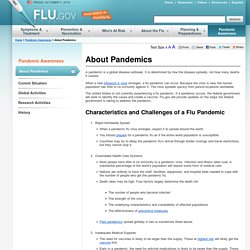
It is determined by how the disease spreads, not how many deaths it causes. When a new influenza A virus emerges, a flu pandemic can occur. Because the virus is new, the human population has little to no immunity against it. Infectious diseases: pathogens. There are a number of interactive features in this e-source: A glossary of terms: any word with a glossary entry is highlighted like this.
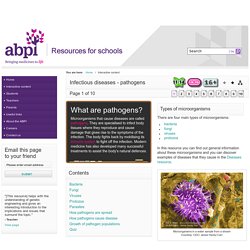
Clicking on the <acronym title='Glossary Item'>highlighted</acronym> word will open a new window with a definition of the word.Quick questions: at the end of a page/section, there is a set of quick questions to test your understanding of the scientific ideas.Animations: most of the animations can be expanded to full screen size, ideal for showing on an interactive whiteboard. Rx for Survival . Deadly Diseases.
Diarrheal Diseases Over the past 150 years, sanitation engineers have dramatically reduced epidemics of cholera, diarrheal dehydration, amoebic dysentery, and typhoid.
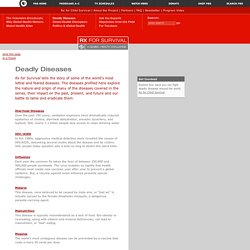
Still, nearly 1.1 billion people lack access to clean drinking water. In the 1980s, aggressive medical detective work revealed the causes of HIV/AIDS, debunking several myths about the disease and its victims. NSF - National Science Foundation. ENY-740/IN722: Emerging Infectious Diseases. Infectious diseases are illnesses caused by the presence and activity of one or more pathogenic agents, including viruses, bacteria, fungi, protozoa, multicellular parasites, and abnormal proteins called prions.

They are transmitted through a variety of means including direct or indirect contact; ingestion (in water or food); transmission of body fluids; inhalation of airborne particles and droplets; transmission by vectors such as mosquitoes, fleas, and ticks; and others. What Are Emerging Infectious Diseases Emerging infectious diseases (EID) are those that have newly appeared or that have existed in the past but are now rapidly increasing in frequency, geographic range, or both.
The US Institute of Medicine defines emerging infections as: "those whose incidence in humans has increased within the past two decades or threatens to increase in the near future. Infectious Disease - Koshland Science Museum. Diseases and Conditions - Diseases and Conditions - Disease and condition information from Mayo Clinic experts. Overview - Infectious diseases. Infectious diseases are disorders caused by organisms — such as bacteria, viruses, fungi or parasites.
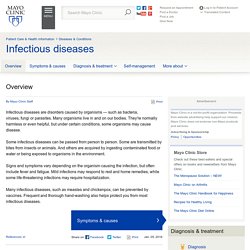
Many organisms live in and on our bodies. They're normally harmless or even helpful, but under certain conditions, some organisms may cause disease. Some infectious diseases can be passed from person to person. Infections. Infections: MedlinePlus. Diseases and Organisms in Healthcare Settings. Acinetobacter Acinetobacter [asz−in−ée−toe–back−ter] is a group of bacteria commonly found in soil and water.
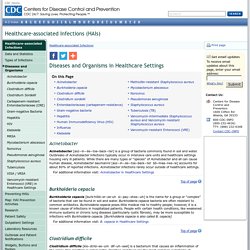
Outbreaks of Acinetobacter infections typically occur in intensive care units and healthcare settings housing very ill patients. While there are many types or “species” of Acinetobacter and all can cause human disease, Acinetobacter baumannii [asz−in−ée−toe–back−ter bō–maa–nee–ie] accounts for about 80% of reported infections.